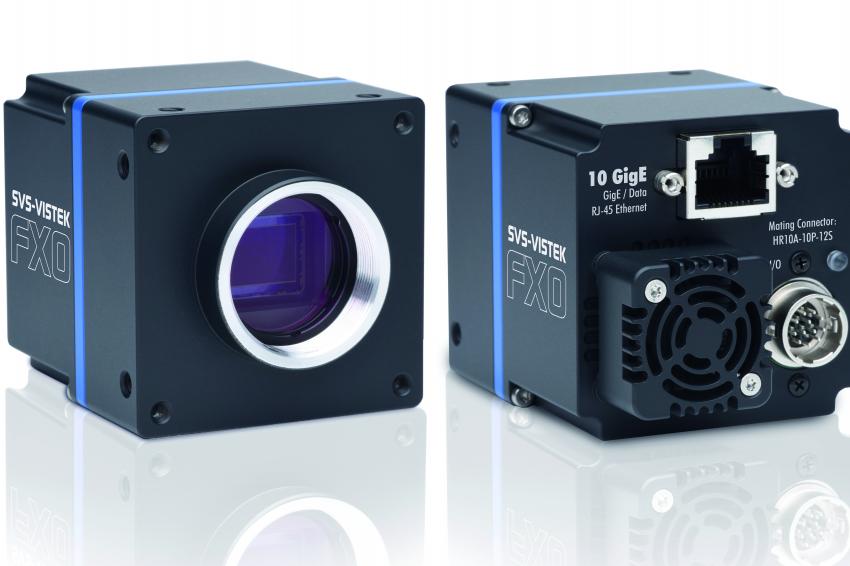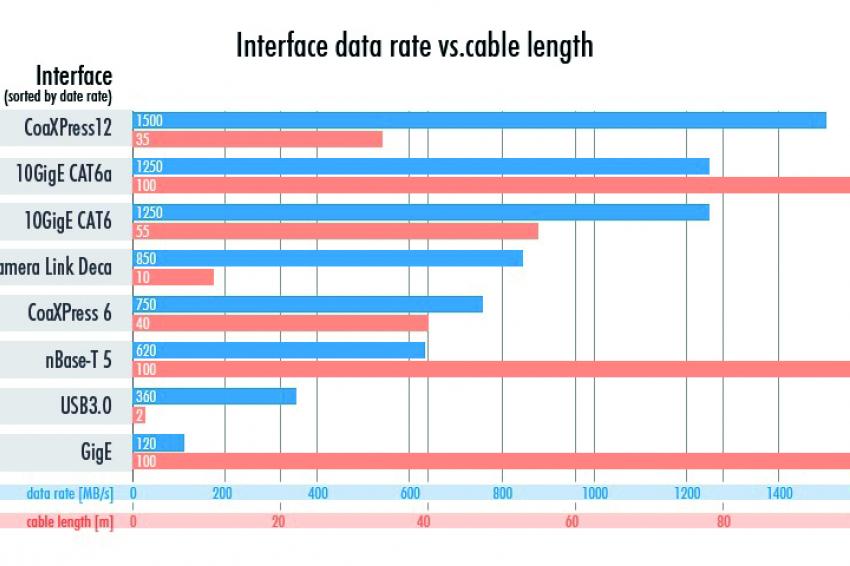10GigE Vision - A New Era for Image Processing
04.11.2020 - The Ethernet-based interface 10GigE Vision has the potential to lead the image processing industry into a new era. This new technology offers a number of innovative features for use in a wide variety of areas.
The sales trend in the machine vision industry has known only one direction for many years, apart from the current, corona-related weakening: It is going up, with growth rates that are usually higher than those of the entire automation environment. The rapid development is not only taking place at the level of image sensors, but also with regard to the evaluation of images (keywords deep learning and artificial intelligence) and the transport of image data via more powerful interfaces. Numerous experts are currently expecting a lot from a new technology being launched: The 10GigE Vision interface is intended to give image processing an additional boost and pushes the limits of what is feasible.
The increasing complexity of automated product tests requires better images with higher resolution. As a result, cameras with resolutions of 12 and more megapixels are being used more and more in many image processing applications. The CMOS sensors used allow high bandwidths of currently up to 90 GigaBit/s and can reproduce very high image frequencies even at high resolutions. To forward the resulting enormous amounts of data from the camera to the PC, powerful interfaces with a high bandwidth are required.
The maximum speeds of image processing interfaces have increased steadily in recent years. According to the current state of the art, systems based on 1GigE Vision enable data transmission of around 120 MB/s, USB3 Vision achieves a maximum of around 360 MB/s and Camera Link systems can deliver up to around 850 MB of data per second. Image processing systems that are equipped with a super modern 4-channel CoaXPress-12 interface currently set the bar highest with net transfer speeds of up to around 5 GB/s. At the moment, the new 10GigE Vision interface will enable around 1,250 MB/s, which raises the question why manufacturers and users of industrial cameras are looking forward to this technology with such high expectations if it does not achieve the speed of CoaXPress. The main reason is: CoaXPress requires a special frame grabber which is fast – but also expensive. 10GigE components from the interface to the cables, however, are already standard technology with cost levels well below other options.
Good Arguments for 10GigE Vision
For users, in addition to the data transmission speed, the maximum possible cable length is also a decisive criterion. This is where 10GigE Vision scores over other interfaces with a maximum data transmission length of up to 100 meters with CAT 6a cables: with USB3-Vision the limit is 2 meters, with Camera Link the end of the flagpole is reached at 10 meters, and CoaXPress reaches its limits at 35 meters. In addition, with 10GigE several cameras or sensors can share one cable due to the packet-oriented protocol and the possible connection via switches - a unique selling point of Ethernet-based interfaces.
10GigE Vision has a lot of advantages over other methods. The Ethernet protocol has proven itself in the industry for many years. In terms of topology as well as software, 10GigE Vision can be scaled transparently from existing 1GigE Vision applications and is already widespread in the server world. The necessary switches are available as inexpensive mass-produced goods. 10GigE is already day-to-day business in many IT areas. 10GigE adapters for PCs also impress with their price of less than 100 US dollars and have been standard on better equipped mainboards for a long time. Special and expensive frame grabbers for image acquisition are unnecessary. Network properties, advantages and disadvantages of the previous 1GigE interface also almost completely apply to 10GigE. And GigE is a well-accepted standard in industrial image processing.
The large selection of standardized components for field cabling also speaks for the future success of the interface novice. Industrial Ethernet cables with M12x8 connections have been “10GigE-ready” for years, and on the I/O side, i.e. for the required control signals and also for LED lighting, the M12x12 standard is ideal for image processors to create robust connections with IP protection class and certification based on industry standards. The infrastructure already exists and has proven itself.
New and Economical Technology
Camera data streams have special technical features. Currently, the configuration of a PC with a 10GigE network card and camera still requires some know-how in order to be able to maximize the theoretical maximum speed of a 10GigE camera. Current cameras with 10GigE such as the hr342XGE from SVS-Vistek with 31 MP or the hr25XGE with 25 MP deliver more than 1.1 GB/s of net image data rate, which is close to the theoretical maximum of the interface. Such a bandwidth naturally requires sufficient CPU capacity on the processing side, but opens up new possibilities, because this enormous bandwidth is available from the hardware inexpensively and in a scalable manner (i.e. almost without changing the software compared to 1GigE Vision) from the application side. For this reason, the first 10GigE systems are already being developed, because they offer such clear technical and economic advantages.
Areas of Application for 10GigE Vision
Many experts see the factory floor as an essential area of application for 10GigE Vision, i.e. the domain of mechanical and plant engineering in many industries such as automotive or food production and wherever high transmission speeds and/or long cable distances are required. The direct consequences of faster image data transmission are that more time is available for the evaluation of the image data and thus more precise statements about the quality of the test object are possible or the throughput per test unit can simply be increased.
It essentially depends on the task at hand whether users will upgrade their existing systems from 1 to 10GigE Vision: For long-running systems without the need for more performance or additional image evaluations, replacing the interface will not bring any economic advantage. If, on the other hand, the faster image acquisition in existing systems allows more throughput or improved image evaluation by changing to 10GigE, the user benefits from a higher inspection quality or an increase in the production flow. A system upgrade by exchanging the PC and the recording unit may possibly make sense in these cases. This shows: 10GigE is an extremely economical high-speed interface.
SVS-Vistek’s forecast is: 10GigE Vision will develop into one of the most important interface technologies in image processing within a few years. When designing new systems, the proportion of 10GigE vision systems will certainly increase significantly in the future.








